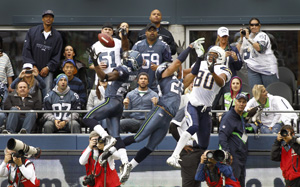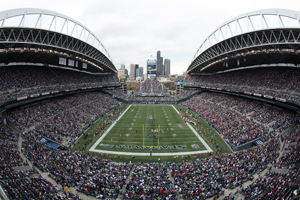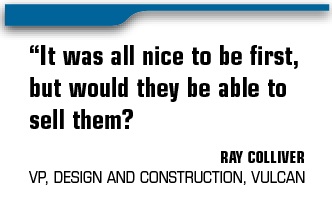CenturyLink Field pioneered the premium field-level experience in the NFL, a trend adopted later at Cowboys Stadium, Lucas Oil Stadium and MetLife Stadium. It’s only one of the ways that the stadium has made noise in the NFL.
The Seahawks and architect Ellerbe Becket, now AECOM, took a huge risk with the field-level boxes, which the team calls Red Zone Suites, because the concept had never been done in the NFL, according to James Poulson, one of the facility’s designers. In addition, it was Ellerbe’s first NFL stadium project and others pointed to the company’s inexperience by questioning whether it made sense to build those suites, in the end zone no less, and charge six-figure fees for a less-than-optimal view of the action.
 |
The field-level Red Zone Suites have since been adopted by three other NFL stadiums.
Photo by: Seattle Seahawks / Seattle Sounders FC |
Seahawks owner Paul Allen was on board with the idea, Poulson said. But other Seahawks executives struggled with the concept, said Ray Colliver, vice president of design and construction for Vulcan, Allen’s development firm.
“It was all nice to be first, but would they be able to sell them?” Colliver said. “It was a different product brought to the marketplace, given that the Kingdome had very few suites and what it did have was very small.”
After a slow start marketing the product, the Seahawks eventually sold all 12 Red Zone Suites, Colliver said. Some players bought units for their families to use.
The new premium-seat product fit well with the team’s vision to develop a stadium to re-engage the fans in a region where King County residents had defeated a proposal to renovate the Kingdome under previous Seahawks owner Ken Behring.
As a result, Behring announced in 1996 that he would relocate the club to California. However, the NFL threatened him with heavy fines, forcing Behring to keep the team in the Pacific Northwest.
Under those circumstances, Allen stepped in and purchased an option to buy the team to ensure that the Seahawks would remain in Seattle. He bought full ownership in 1997 after local voters narrowly approved public financing to build a
$430 million stadium.
“It was a contentious vote … but that facility kept the team in Seattle,” Colliver said.
The Seahawks took control of stadium design and were responsible for cost overruns. In one of the league’s smaller cities, they took a conservative approach, opening with 82 suites with the flexibility to add more skyboxes in the future.
The market responded, due in large part to the Seahawks’ advancing to the Super Bowl during the 2005 season, Colliver said. CenturyLink Field now has 112 suites, with space to build even more.
The Red Zone Suites are linked to the stadium’s other defining feature: Noise. They’re tucked beneath the Hawks Nest bleachers in the stadium’s north end, where 3,000 rabid Seahawks fans pound their feet on metal bench seats, wreaking havoc for opponents threatening to score at that end of the field.
After 10 years, the 67,000-seat stadium is recognized across the NFL as one of the loudest venues and typically ranks first in false starts for opponents’ offenses.
The stadium sits on a tight urban footprint at the site of the old Kingdome across the street from Safeco Field. In an outdoor building also designed for Major League Soccer, the upper deck juts out over the lower bowl, with the European-style roof canopy acting as a sound barrier.
Husky Stadium, where Allen attended college football games as a University of Washington student, influenced the Hawks Nest and the open views to the city’s downtown district, Poulson said.
Those elements also combine for a deafening roar on game days.
Over the past decade, the Seahawks have made $30 million in improvements in the facility, Colliver said. The Cadillac
 |
The stadium is recognized across the NFL as one of the loudest venues.
Photo by: Getty Images |
Reserve Club, an all-inclusive package with ticket prices in the range of $500 a game, opened in 2007 in the northeast corner of the club level. Membership is limited to 90 individuals. The 3,600-square-foot lounge took over old concourse space.
Most recently, the Seahawks installed two new Mitsubishi Electric video boards this year.
Some future upgrades may cater to the stadium’s other tenant, the MLS’s Seattle Sounders FC, for whom Allen is one of the owners. The Sounders have been a tremendous success at the gate, drawing close to 40,000 spectators a game, and the organization needs to find a way to expand the team store to accommodate the 5-year-old club, said Peter McLoughlin, president of both franchises.
“The biggest change here is the introduction of the Sounders,” Colliver said. “That was one of the goals of the public stadium authority.”
As for the Red Zone Suites, they could morph into larger party suites by expanding into space behind the existing units.
“Now with the amenities people are adding to those suites in the newer facilities, they are a bit more advanced than ours,” Colliver said.
CENTURYLINK FIELD
ORIGINAL COST: $430 MILLION
| | 2002 | 2012 |
| Luxury suites | 82 | 112 |
| Luxury suite seats | 1,632 | 2,306 |
| Club seats | 7,700 | 8,200 |
| Club lounges | 2 | 6 |
| General concessionaire | Aramark | Levy Restaurants |
| Premium caterer | Aramark | Levy Restaurants |
| Field-level dining (Sounders FC only) | None | 15 tables |
| Permanent concession stands | 38 | 46 |
| Premium concessions | 8 | 47 |
| Beer portables | 47 | 55 |
| Vendors in seating area | 125 | 165 |
| Soda pouring rights | Coca-Cola | Coca-Cola |
| Point-of-sale terminals | 417 | 1,042 |
| Recycle bins | 75 | 400 |
| Permanent novelty stands | 14 | 15 |
| Playing surface | FieldTurf | FieldTurf Revolution |
| Parking spaces | 3,100 | 2,800 |
| Electric vehicle chargers | 0 | 6 |
| TV monitors | 841 | 500 |
Notes: The number of TV monitors decreased because the stadium opened with a feature called “concession TV” but because of sun glare the concept was revised. The group plans to install new high-def monitors next year.






